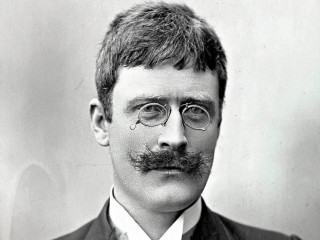
Knut Hamsun biography
Date of birth : 1859-08-04
Date of death : 1952-02-19
Birthplace : Lom, Gudbrandsdal, Norway
Nationality : Norwegian
Category : Famous Figures
Last modified : 2011-08-31
Credited as : Novelist, author, Nobel Prize in Literature
The novels of the Norwegian author Knut Hamsun introduced a new style and concept of character into European literature. He received the 1920 Nobel Prize in literature.
Knut Hamsun was born on Aug. 4, 1859, in Lom (Gudbrandsdal). When he was 3, the family moved above the Arctic Circle, where the majestic Nordland nature left a lasting impression on his mind and art. After an impoverished and lonely childhood with little schooling, he worked for 14 years at a variety of jobs in Norway and America while struggling to become a writer.
Hamsun's breakthrough came when he was nearly 30, with the anonymously published first part of Hunger (1888), which made him immediately famous in Scandinavia. Based on his own experiences as a starving writer, the novel departed sharply from the prevailing literary realism. It does not give an objective picture of the world: everything is seen through the protagonist's eyes, and reality is shaped and colored by his physical and mental state. Hamsun is not concerned with social issues but with the mental activity and bizarre actions of his unique, tormented hero. Hamsun's style—lyric and brutal, serious and comic—was as individualistic as his hero.
In a famous essay, "On the Unconscious Life of the Mind" (1890), as well as in public attacks on Norway's reigning literary giants, Hamsun called for a radically new kind of literature, devoted to the individual, whom he saw as governed by psychic activity too delicate to be communicated through prevailing literary techniques. His views were based on personal experience and on his reading of Fyodor Dostoevsky and certain pre-Freudian philosophers of the unconscious.
Hamsun's authorship is usually divided into two periods. The greatest novels of the first period—Hunger (1890), Mysteries (1892), Pan (1894), and Victoria (1898)— deal with outsiders, socially and metaphysically alone. Beginning with Pan, one of Norwegian literature's most beautiful novels, a new lyric tone appears, as nature begins to play a more prominent role.
Hamsun's second period began in 1913, although not abruptly. From this time on, his novels are told in a fairly traditional third-person form and deal with the lives of many people. These novels also express a deep-rooted dislike for all aspects of modern culture and a love (which amounts to envy) for simple people who live out their lives close to the soil. Hamsun himself settled finally with his family on a large farm in southern Norway but spent much time away from it, writing novels which exhort others to return to the soil.
The most famous of Hamsun's later novels, Growth of the Soil (1917), is the monumental story of a man—the opposite in every respect of Hamsun's early heroes—who comes to the wilderness and carves out a farm with his bare hands, working in harmony, rather than in competition, with nature.
By far the richest of Hamsun's later books are the three novels about the fabulous liar, musician, and inventor August: Vagabonds (1927), August (1930), and The Road Leads On (1933). August is the restless, eternally dissatisfied wanderer from the first novels, now become a kind of cultural hero—or villain—who acts as a catalyst in the chemistry of man's discontent with the status quo.
During World War II Hamsun supported the Nazi government in occupied Norway. After the war he was heavily fined but escaped further punishment because he was judged mentally incompetent. His last book, On Overgrown Paths (1949), written when he was nearing 90, brilliantly contradicts this judgment. In its lyricism, its humor, its merciless study of the outsider—this time Hamsun himself—it compares favorably with his first novels. He died at his farm, Norholm, on Feb. 19, 1952.
















